bonnet FIAT DUCATO 2007 Owner handbook (in English)
[x] Cancel search | Manufacturer: FIAT, Model Year: 2007, Model line: DUCATO, Model: FIAT DUCATO 2007Pages: 282, PDF Size: 4.49 MB
Page 5 of 282
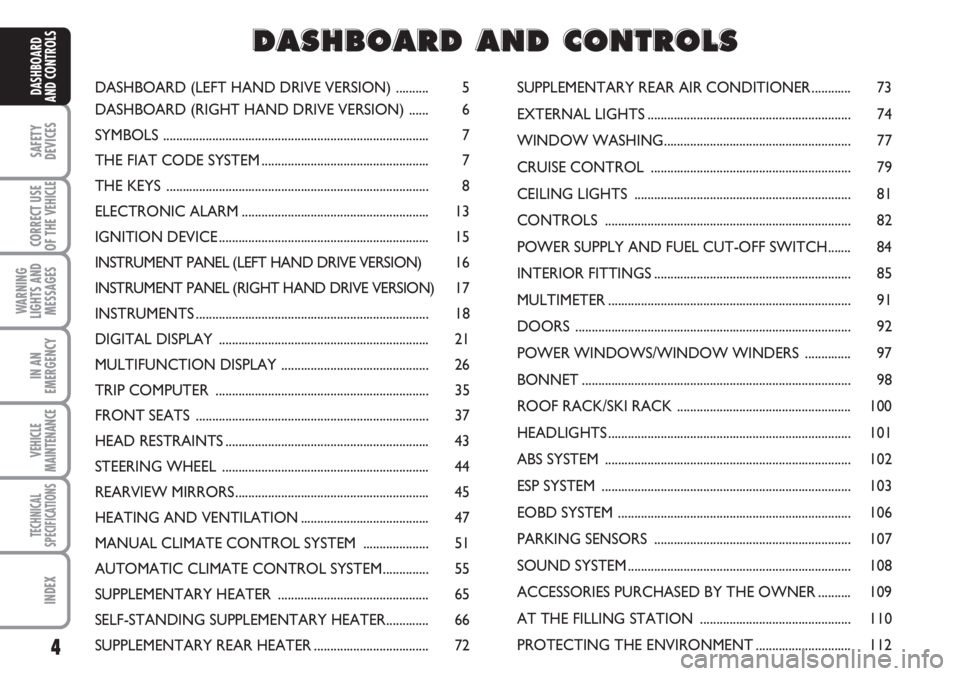
4
SAFETY
DEVICES
CORRECT USE
OF THE
VEHICLE
WARNING
LIGHTS AND
MESSAGES
IN AN
EMERGENCY
VEHICLE
MAINTENANCE
TECHNICAL
SPECIFICATIONS
INDEX
DASHBOARD
AND CONTROLSDASHBOARD (LEFT HAND DRIVE VERSION) .......... 5
DASHBOARD (RIGHT HAND DRIVE VERSION) ...... 6
SYMBOLS ................................................................................. 7
THE FIAT CODE SYSTEM ................................................... 7
THE KEYS ................................................................................ 8
ELECTRONIC ALARM ......................................................... 13
IGNITION DEVICE ................................................................ 15
INSTRUMENT PANEL (LEFT HAND DRIVE VERSION) 16
INSTRUMENT PANEL (RIGHT HAND DRIVE VERSION) 17
INSTRUMENTS ....................................................................... 18
DIGITAL DISPLAY ................................................................ 21
MULTIFUNCTION DISPLAY ............................................. 26
TRIP COMPUTER ................................................................. 35
FRONT SEATS ....................................................................... 37
HEAD RESTRAINTS .............................................................. 43
STEERING WHEEL ............................................................... 44
REARVIEW MIRRORS ........................................................... 45
HEATING AND VENTILATION ....................................... 47
MANUAL CLIMATE CONTROL SYSTEM .................... 51
AUTOMATIC CLIMATE CONTROL SYSTEM .............. 55
SUPPLEMENTARY HEATER .............................................. 65
SELF-STANDING SUPPLEMENTARY HEATER............. 66
SUPPLEMENTARY REAR HEATER ................................... 72SUPPLEMENTARY REAR AIR CONDITIONER ............ 73
EXTERNAL LIGHTS .............................................................. 74
WINDOW WASHING......................................................... 77
CRUISE CONTROL ............................................................. 79
CEILING LIGHTS .................................................................. 81
CONTROLS ........................................................................... 82
POWER SUPPLY AND FUEL CUT-OFF SWITCH....... 84
INTERIOR FITTINGS ............................................................ 85
MULTIMETER .......................................................................... 91
DOORS .................................................................................... 92
POWER WINDOWS/WINDOW WINDERS .............. 97
BONNET .................................................................................. 98
ROOF RACK/SKI RACK ..................................................... 100
HEADLIGHTS .......................................................................... 101
ABS SYSTEM ........................................................................... 102
ESP SYSTEM ............................................................................ 103
EOBD SYSTEM ....................................................................... 106
PARKING SENSORS ............................................................ 107
SOUND SYSTEM .................................................................... 108
ACCESSORIES PURCHASED BY THE OWNER .......... 109
AT THE FILLING STATION .............................................. 110
PROTECTING THE ENVIRONMENT ............................. 112
D D
A A
S S
H H
B B
O O
A A
R R
D D
A A
N N
D D
C C
O O
N N
T T
R R
O O
L L
S S
Page 8 of 282
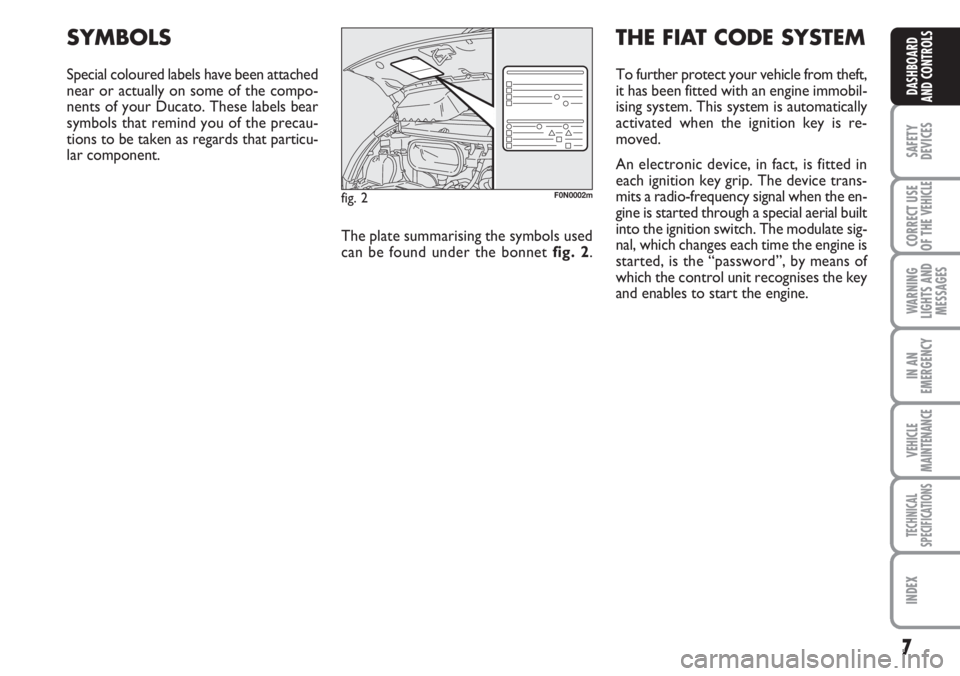
7
SAFETY
DEVICES
CORRECT USE
OF THE
VEHICLE
WARNING
LIGHTS AND
MESSAGES
IN AN
EMERGENCY
VEHICLE
MAINTENANCE
TECHNICAL
SPECIFICATIONS
INDEX
DASHBOARD
AND CONTROLS
SYMBOLS
Special coloured labels have been attached
near or actually on some of the compo-
nents of your Ducato. These labels bear
symbols that remind you of the precau-
tions to be taken as regards that particu-
lar component.
The plate summarising the symbols used
can be found under the bonnet fig. 2.
THE FIAT CODE SYSTEM
To further protect your vehicle from theft,
it has been fitted with an engine immobil-
ising system. This system is automatically
activated when the ignition key is re-
moved.
An electronic device, in fact, is fitted in
each ignition key grip. The device trans-
mits a radio-frequency signal when the en-
gine is started through a special aerial built
into the ignition switch. The modulate sig-
nal, which changes each time the engine is
started, is the “password”, by means of
which the control unit recognises the key
and enables to start the engine.
fig. 2F0N0002m
Page 14 of 282
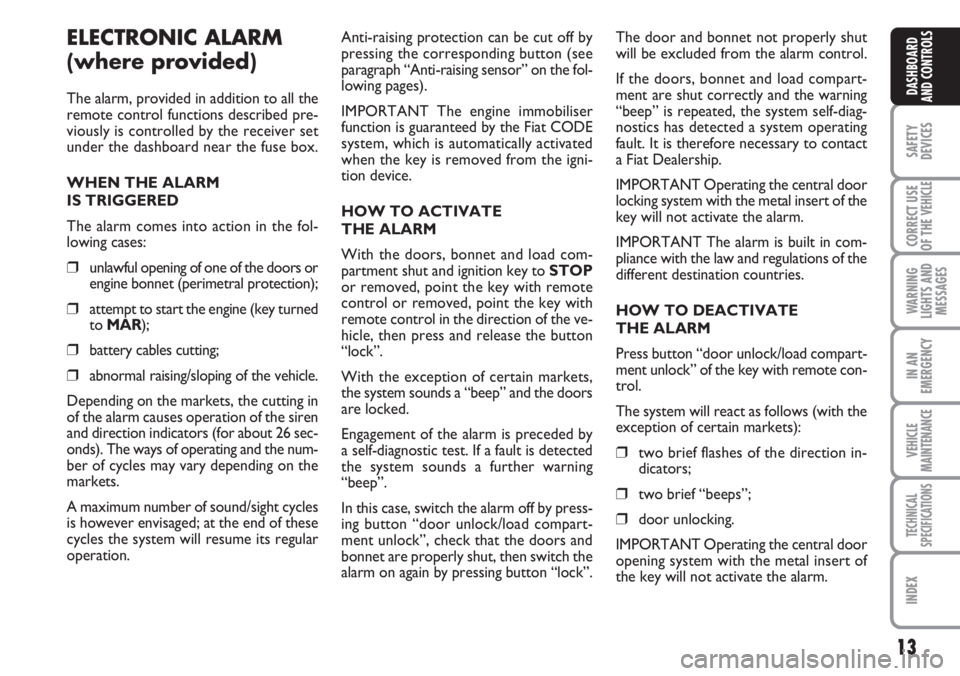
13
SAFETY
DEVICES
CORRECT USE
OF THE
VEHICLE
WARNING
LIGHTS AND
MESSAGES
IN AN
EMERGENCY
VEHICLE
MAINTENANCE
TECHNICAL
SPECIFICATIONS
INDEX
DASHBOARD
AND CONTROLS
ELECTRONIC ALARM
(where provided)
The alarm, provided in addition to all the
remote control functions described pre-
viously is controlled by the receiver set
under the dashboard near the fuse box.
WHEN THE ALARM
IS TRIGGERED
The alarm comes into action in the fol-
lowing cases:
❒unlawful opening of one of the doors or
engine bonnet (perimetral protection);
❒attempt to start the engine (key turned
to MAR);
❒battery cables cutting;
❒abnormal raising/sloping of the vehicle.
Depending on the markets, the cutting in
of the alarm causes operation of the siren
and direction indicators (for about 26 sec-
onds). The ways of operating and the num-
ber of cycles may vary depending on the
markets.
A maximum number of sound/sight cycles
is however envisaged; at the end of these
cycles the system will resume its regular
operation.Anti-raising protection can be cut off by
pressing the corresponding button (see
paragraph “Anti-raising sensor” on the fol-
lowing pages).
IMPORTANT The engine immobiliser
function is guaranteed by the Fiat CODE
system, which is automatically activated
when the key is removed from the igni-
tion device.
HOW TO ACTIVATE
THE ALARM
With the doors, bonnet and load com-
partment shut and ignition key toSTOP
or removed, point the key with remote
control or removed, point the key with
remote control in the direction of the ve-
hicle, then press and release the button
“lock”.
With the exception of certain markets,
the system sounds a “beep” and the doors
are locked.
Engagement of the alarm is preceded by
a self-diagnostic test. If a fault is detected
the system sounds a further warning
“beep”.
In this case, switch the alarm off by press-
ing button “door unlock/load compart-
ment unlock”, check that the doors and
bonnet are properly shut, then switch the
alarm on again by pressing button “lock”.The door and bonnet not properly shut
will be excluded from the alarm control.
If the doors, bonnet and load compart-
ment are shut correctly and the warning
“beep” is repeated, the system self-diag-
nostics has detected a system operating
fault. It is therefore necessary to contact
a Fiat Dealership.
IMPORTANT Operating the central door
locking system with the metal insert of the
key will not activate the alarm.
IMPORTANT The alarm is built in com-
pliance with the law and regulations of the
different destination countries.
HOW TO DEACTIVATE
THE ALARM
Press button “door unlock/load compart-
ment unlock” of the key with remote con-
trol.
The system will react as follows (with the
exception of certain markets):
❒two brief flashes of the direction in-
dicators;
❒two brief “beeps”;
❒door unlocking.
IMPORTANT Operating the central door
opening system with the metal insert of
the key will not activate the alarm.
Page 99 of 282
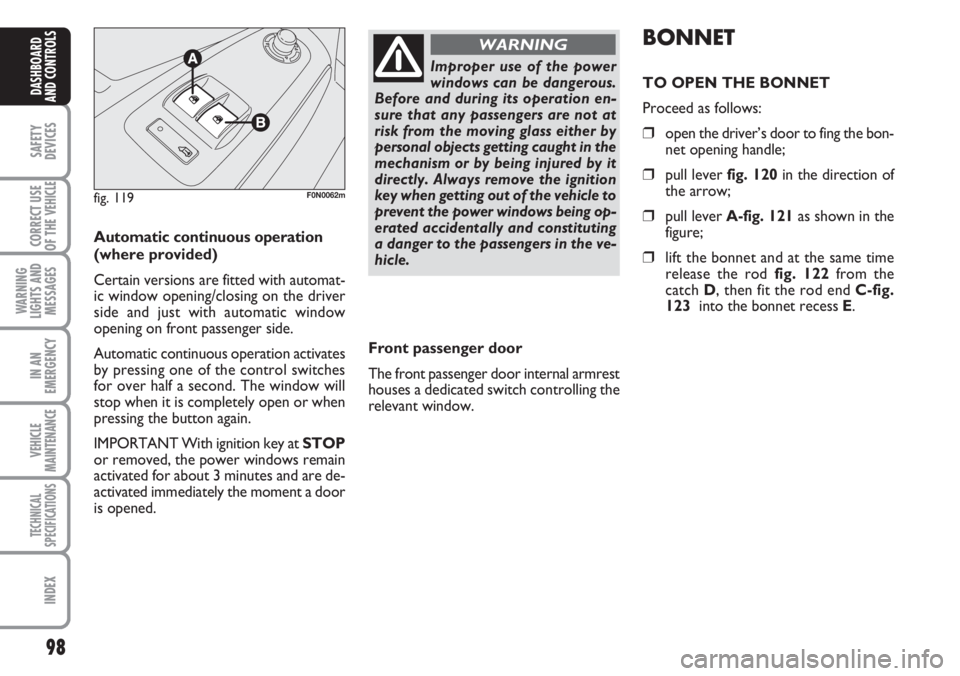
98
SAFETY
DEVICES
CORRECT USE
OF THE
VEHICLE
WARNING
LIGHTS AND
MESSAGES
IN AN
EMERGENCY
VEHICLE
MAINTENANCE
TECHNICAL
SPECIFICATIONS
INDEX
DASHBOARD
AND CONTROLS
Automatic continuous operation
(where provided)
Certain versions are fitted with automat-
ic window opening/closing on the driver
side and just with automatic window
opening on front passenger side.
Automatic continuous operation activates
by pressing one of the control switches
for over half a second. The window will
stop when it is completely open or when
pressing the button again.
IMPORTANT With ignition key at STOP
or removed, the power windows remain
activated for about 3 minutes and are de-
activated immediately the moment a door
is opened.
fig. 119F0N0062m
Improper use of the power
windows can be dangerous.
Before and during its operation en-
sure that any passengers are not at
risk from the moving glass either by
personal objects getting caught in the
mechanism or by being injured by it
directly. Always remove the ignition
key when getting out of the vehicle to
prevent the power windows being op-
erated accidentally and constituting
a danger to the passengers in the ve-
hicle.
WARNINGBONNET
TO OPEN THE BONNET
Proceed as follows:
❒open the driver’s door to fing the bon-
net opening handle;
❒pull lever fig. 120in the direction of
the arrow;
❒pull lever A-fig. 121as shown in the
figure;
❒lift the bonnet and at the same time
release the rod fig. 122 from the
catch D, then fit the rod end C-fig.
123 into the bonnet recess E.
Front passenger door
The front passenger door internal armrest
houses a dedicated switch controlling the
relevant window.
Page 100 of 282
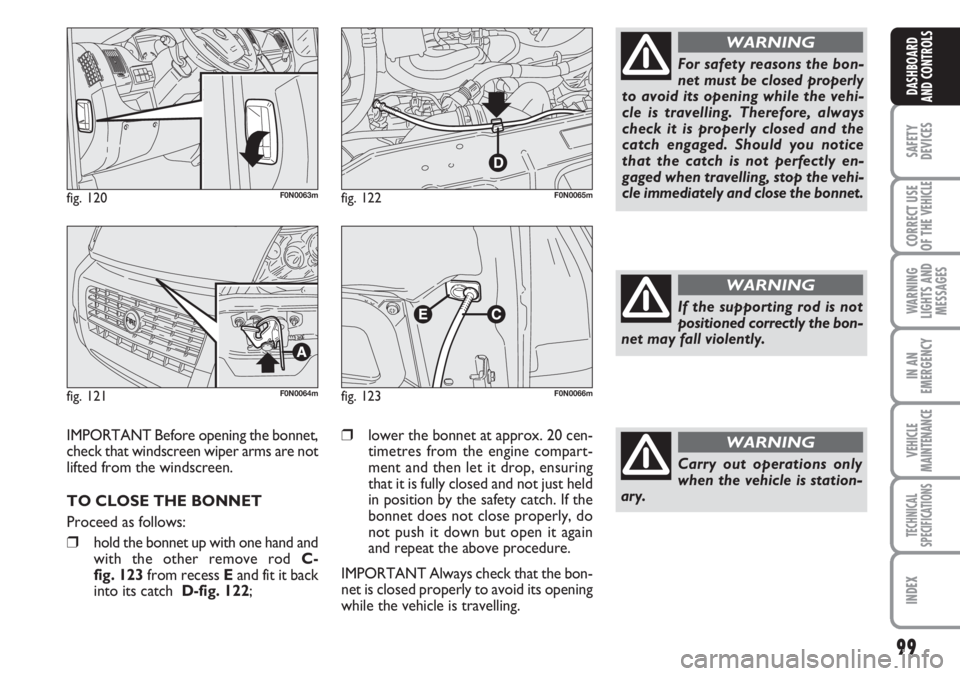
99
SAFETY
DEVICES
CORRECT USE
OF THE
VEHICLE
WARNING
LIGHTS AND
MESSAGES
IN AN
EMERGENCY
VEHICLE
MAINTENANCE
TECHNICAL
SPECIFICATIONS
INDEX
DASHBOARD
AND CONTROLS
fig. 120F0N0063m
fig. 121F0N0064m
fig. 122F0N0065m
IMPORTANT Before opening the bonnet,
check that windscreen wiper arms are not
lifted from the windscreen.
TO CLOSE THE BONNET
Proceed as follows:
❒hold the bonnet up with one hand and
with the other remove rod C-
fig. 123 from recess Eand fit it back
into its catch D-fig. 122;
❒lower the bonnet at approx. 20 cen-
timetres from the engine compart-
ment and then let it drop, ensuring
that it is fully closed and not just held
in position by the safety catch. If the
bonnet does not close properly, do
not push it down but open it again
and repeat the above procedure.
IMPORTANT Always check that the bon-
net is closed properly to avoid its opening
while the vehicle is travelling.
fig. 123F0N0066m
For safety reasons the bon-
net must be closed properly
to avoid its opening while the vehi-
cle is travelling. Therefore, always
check it is properly closed and the
catch engaged. Should you notice
that the catch is not perfectly en-
gaged when travelling, stop the vehi-
cle immediately and close the bonnet.
WARNING
If the supporting rod is not
positioned correctly the bon-
net may fall violently.
WARNING
Carry out operations only
when the vehicle is station-
ary.
WARNING
Page 196 of 282
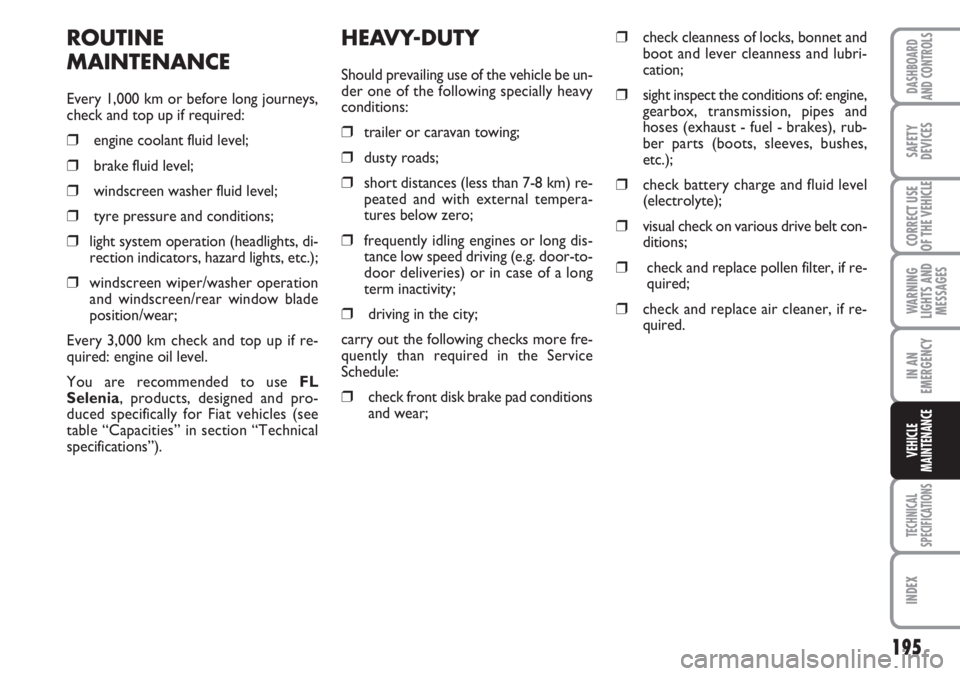
195
WARNING
LIGHTS AND
MESSAGES
TECHNICAL
SPECIFICATIONS
INDEX
DASHBOARD
AND CONTROLS
SAFETY
DEVICES
CORRECT USE
OF THE VEHICLE
IN AN
EMERGENCY
VEHICLE
MAINTENANCE
HEAVY-DUTY
Should prevailing use of the vehicle be un-
der one of the following specially heavy
conditions:
❒trailer or caravan towing;
❒dusty roads;
❒short distances (less than 7-8 km) re-
peated and with external tempera-
tures below zero;
❒frequently idling engines or long dis-
tance low speed driving (e.g. door-to-
door deliveries) or in case of a long
term inactivity;
❒driving in the city;
carry out the following checks more fre-
quently than required in the Service
Schedule:
❒check front disk brake pad conditions
and wear;
❒check cleanness of locks, bonnet and
boot and lever cleanness and lubri-
cation;
❒sight inspect the conditions of: engine,
gearbox, transmission, pipes and
hoses (exhaust - fuel - brakes), rub-
ber parts (boots, sleeves, bushes,
etc.);
❒check battery charge and fluid level
(electrolyte);
❒visual check on various drive belt con-
ditions;
❒check and replace pollen filter, if re-
quired;
❒check and replace air cleaner, if re-
quired.
ROUTINE
MAINTENANCE
Every 1,000 km or before long journeys,
check and top up if required:
❒engine coolant fluid level;
❒brake fluid level;
❒windscreen washer fluid level;
❒tyre pressure and conditions;
❒light system operation (headlights, di-
rection indicators, hazard lights, etc.);
❒windscreen wiper/washer operation
and windscreen/rear window blade
position/wear;
Every 3,000 km check and top up if re-
quired: engine oil level.
You are recommended to use FL
Selenia, products, designed and pro-
duced specifically for Fiat vehicles (see
table “Capacities” in section “Technical
specifications”).
Page 210 of 282
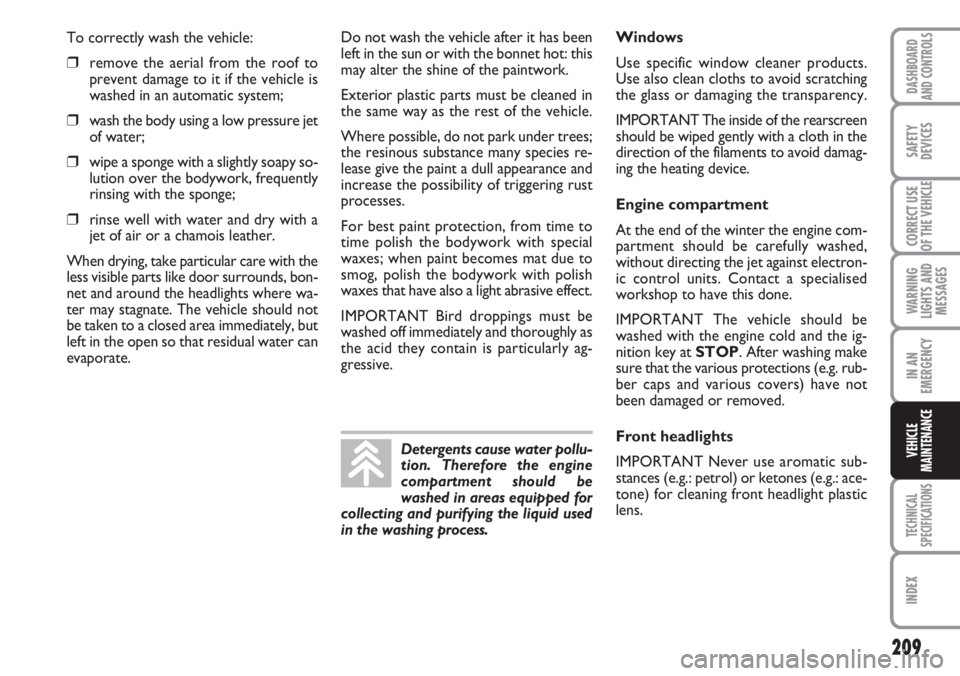
209
WARNING
LIGHTS AND
MESSAGES
TECHNICAL
SPECIFICATIONS
INDEX
DASHBOARD
AND CONTROLS
SAFETY
DEVICES
CORRECT USE
OF THE VEHICLE
IN AN
EMERGENCY
VEHICLE
MAINTENANCE
To correctly wash the vehicle:
❒remove the aerial from the roof to
prevent damage to it if the vehicle is
washed in an automatic system;
❒wash the body using a low pressure jet
of water;
❒wipe a sponge with a slightly soapy so-
lution over the bodywork, frequently
rinsing with the sponge;
❒rinse well with water and dry with a
jet of air or a chamois leather.
When drying, take particular care with the
less visible parts like door surrounds, bon-
net and around the headlights where wa-
ter may stagnate. The vehicle should not
be taken to a closed area immediately, but
left in the open so that residual water can
evaporate.Do not wash the vehicle after it has been
left in the sun or with the bonnet hot: this
may alter the shine of the paintwork.
Exterior plastic parts must be cleaned in
the same way as the rest of the vehicle.
Where possible, do not park under trees;
the resinous substance many species re-
lease give the paint a dull appearance and
increase the possibility of triggering rust
processes.
For best paint protection, from time to
time polish the bodywork with special
waxes; when paint becomes mat due to
smog, polish the bodywork with polish
waxes that have also a light abrasive effect.
IMPORTANT Bird droppings must be
washed off immediately and thoroughly as
the acid they contain is particularly ag-
gressive.
Detergents cause water pollu-
tion. Therefore the engine
compartment should be
washed in areas equipped for
collecting and purifying the liquid used
in the washing process.
Windows
Use specific window cleaner products.
Use also clean cloths to avoid scratching
the glass or damaging the transparency.
IMPORTANT The inside of the rearscreen
should be wiped gently with a cloth in the
direction of the filaments to avoid damag-
ing the heating device.
Engine compartment
At the end of the winter the engine com-
partment should be carefully washed,
without directing the jet against electron-
ic control units. Contact a specialised
workshop to have this done.
IMPORTANT The vehicle should be
washed with the engine cold and the ig-
nition key at STOP. After washing make
sure that the various protections (e.g. rub-
ber caps and various covers) have not
been damaged or removed.
Front headlights
IMPORTANT Never use aromatic sub-
stances (e.g.: petrol) or ketones (e.g.: ace-
tone) for cleaning front headlight plastic
lens.
Page 271 of 282

270
WARNING
LIGHTS AND
MESSAGES
DASHBOARD
AND CONTROLS
SAFETY
DEVICES
CORRECT USE
OF THE
VEHICLE
IN AN
EMERGENCY
VEHICLE
MAINTENANCE
TECHNICAL
SPECIFICATIONS
INDEX
– jump starting .................................. 158
– recharging......................................... 185
– replacing .......................................... 202
Bodywork
– maintenance ................................... 208
– version codes ................................. 212
Bonnet .................................................... 98
Brake Assist
(brake assist in an emergency) ....... 103
Brake fluid level..................................... 200
Brakes
– fluid level ......................................... 200
– technical data ................................. 218
Bulb (replacement)
– bulb types ........................................ 168
– general instructions ....................... 168
Ceiling lights
– front................................................... 81
– rear .................................................... 82
Chassis (marking) ................................ 213
Checking fluid levels ............................ 196Child restraint systems
(specifications for use)...................... 119
Cigar lighter .......................................... 87
CO
2exhaust emissions ..................... 265
Code card............................................... 8
Consumption
– engine oil .......................................... 198
– fuel ..................................................... 264
Containing running costs .................... 138
Control buttons .................................. 82
Correct use of the vehicle ................. 133
Cruise Control .................................... 79
Current outlet....................................... 88
Dashboard (left hand drive version) 5
Dashboard (right hand drive version) 6
Dashboard and controls ..................... 4
Dead lock device
– activation/deactivation .................. 94
Digital display ......................................... 20
Dimensions ........................................... 223
Dipped beam headlights
– bulb replacement .......................... 171
ABS ........................................................ 102
Accessories purchased by
the user ............................................... 109
Additional climate control system
(rear). .................................................... 73
Additional rear heater ......................... 72
Air bags (front)...................................... 123
Air bags (side)........................................ 125
Air cleaner.............................................. 201
Air vents ................................................ 47
Armrest
– front................................................... 38
Ashtray .................................................... 87
ASR ......................................................... 105
– activation/deactivation ................. 105
At the filling station .............................. 125
Automatic climate control system .. 55
Automatic headlight sensor
(daylight sensor) ................................. 92
Battery
– checking the charge ...................... 202
I I
N N
D D
E E
X X